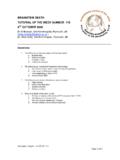Transcription of TEM applications - Nanomegas
1 Precession electron diffraction and TEM applications S. Nicolopoulos* , * consultant IUCr Electron Crystallography Comission Nanomegas SPRL, Blvd Edmond Machtens 79, B-1080 Brussels, Belgium , Abstract Despite its success in solving crystal structures, X-Ray diffraction has serious limitations to deal with nanostructures of nm size level. After the discovery of the precession electron diffraction by Vincent and Midgley and the introduction of dedicated precession electron diffraction devices to TEM microscopes, several nanocrystal structure determinations have been obtained so far. Recent new applications like precession 3D diffraction tomography , precession assisted 3D image tomography and (EBSD-TEM like).
2 Orientation phase mapping widen considerably the application field of TEM for electron crystallography. Introduction Crystal structure determination of a single crystal involves collection measurement of diffraction intensities and mathematical treatment (like direct methods) to solve the crystal structure ( ) Diffraction intensities are defined as kinematic and there exist a simple relationship between structure factor F hkl and (hkl). reflection's intensity. However, to study crystal structure of individual nanocrystals is only possible with transmission electron microscopy and not possible with single crystal or (or powder) X-Ray where the minimum crystal size is restricted to 5 microns (for Synchrotron single crystal experiments).
3 On the other hand , in any TEM we can obtain a high resolution image of any nanoparticle as well its associated electron diffraction pattern in the back focal plane of the electron microscope ( ). Dynamical electron diffraction and precession electron diffraction Although we can measure accurately electron diffraction (ED) intensities for any nanocrystal we cannot unfortunately use this information to solve its structure using the standard mathematical tools like in X-Ray reason is that electron interaction with matter is about 104 stronger than X-Rays and this results to strong dynamical scattering that may alter diffracted intensities so much that cannot be trusted for crystal structure refinement, unless crystal thickness is very thin (< 1 nm).
4 This is why electron crystallography was not until recently routine structure identification tool like X-Ray crystallography [1-2] where beam-matter interactions are kinematical and structure factors can be directly derived from intensity data. For example in (left) we can observe a clear example of how dynamical intensities of a rather thick sample (> 1 nm). are completely different from their ideal values-see simulated pattern on the right- and how space group extinctions are clearly violated in the "dynamical diffraction pattern", as intensities are clearly seen in places (red circles) where should be totally absent (like in X-Ray case). Electron beam precession technique invented by Vincent , Midgley [3] in Bristol University (UK) gives a solution to this problem by increasing the kinematical character of the electron technique is equivalent to the X-Ray Buerger precession technique, where instead precessing the crystal (like in X-Ray precession) , electron beam is tilted and precessed on a cone surface having a common axis with the TEM.
5 Optical obtain a stationary precession electron diffraction (PED) pattern instead of ring reflections ( ) a simultaneous descan of the diffracted beam is realized by means of image shift TEM coils. As a result ofelectron beam precession, only few reflections are simultaneously excited in dynamical conditions and the resulting diffraction pattern can be considered close to kinematical or two beam the resulting PED pattern kinematically forbidden reflections and multiple scattering are virtually eliminated (or greatly reduced) and space group identification can be easily done. By increasing precession angle ( ) Ewald sphere covers bigger area in the reciprocal space and as a result more reflections are seen; at higher precession angle value (about 15-20 mrad) PED intensities change dramatically and become much closer to kinematical (X-Ray like) values [4].
6 Maximum precession angles are related to maximum TEM dark field tilt angles and do depend on each particular TEM ;such maximum values usually range from 34-68 mrad (2-4 ). (a) Schematics of crystal structure solution in X-Ray crystallography (b) schematics of image and diffraction in a transmission electron microscope (TEM). Scan and descan the beam to have stationary pattern (left) [001] ED pattern of melilite mineral ( a=b= c= P -4 2l m) and simulated (kinematicel). ED pattern: red circles depict forbidden reflections that do appear in case of dynamical pattern (right) schematics of beam precession in a TEM. ( left to right) [111] diffraction pattern of mayenite mineral (cubic a= A) at different precession angles 0 mrad for complete dynamical pattern , 40 mrad precession angle quasi-kinematical electron diffraction pattern.
7 The first TEM precession interfaces have been developed by University teams in Oslo [5,6], Bologna [7,8]. and by , team in Northwestern University [4] ; however it was not until 2004 where our team in Brussels (ULB) developed [9] and supplied on a wide user basis precession systems (> 55. worldwide) able to retrofit in any modern TEM , when PED spread widely in many electron microscopy laboratories resulting in numerous publications and gaining recognition as innovative structure analysis technique in both TEM and X-Ray crystallographic communities [10-18]. Precession devices (like the firstly developed "spinning star") and the latest digital version DigiSTAR ( ) can be retrofitted to any modern TEM (like Tecnai 10-30 LaB6/FEG, Jeol 2100-2200 LaB6/FEG or the Zeiss Libra 120-200) or older TEM versions (like Philips CM 10-300 , Jeol 2000-2010 or Zeiss 912).
8 PED device (hardware) can be plugged in the TEM electronic boards taking control of particular type of lenses: "beam tilt" (a pair of 4. lenses used for "beam scan") and "image shift" (a pair of 4 lenses used for "beam de-scan")."De- scanning" the beam is important to obtain a spot like PED pattern,otherwise patterns would have show circles-in place of ED spots-with diameter depending on precession angle ( right).Precession frequency can vary from kHz (high frequency as 100 Hz is requested for studying beam sensitive materials and to be used in combination with beam scanning applications - like ASTAR or ADT as will shown later). Determination of space and point group symmetries with precession One of the most straightforward applications of PED is symmery determination without need of CBED.
9 (convergent beam) information. By using PED the number of reflections present in the different Laue zones (LZ) increases strongly with increasing precession angle and it becomes easy to identify shifts and the periodicity difference between reflections located in those LZ. Shifts between observed LZ are related with Bravais lattice symmetry and observed LZ periodicity differences are related with presence (or not) of glide planes; such information can be used to identify possible space group symmetry of crystal without need of et al [14-17] has shown how are related all different Laue classes/space & point group symmetries with observed ZOLZ/FOLZ in PED patterns. Visibility of ZOLZ/FOLZ is much greater when an TEM energy filter [18] is used ( ).
10 Determination of crystal structures with precession To solve 3D crystal structures we need a set of 3D hkl PED (quasi-kinematical) intensities, using the same mathematical procedures/software like in X-Ray diffraction for structure exist 3 main strategies from 3D electron diffraction data collection: a) data collected from different Zone Axis (ZA). patterns b)data collected with recently developed ADT-3D (automatic precession diffraction tomography technique) and c) data collected from ZA PED patterns in combination with powder X-Ray patterns. In (a) approach a number of few (3 or more) ZA in a TEM ( Courtesy MPI Dresden) is used and PED intensities can be measured automatically [19] from individual ZA on a CCD camera, image plate, photo film or high dynamic range detector (electron diffractometer [11]).






